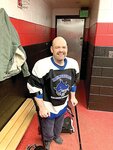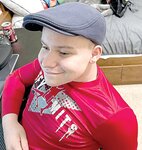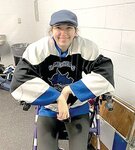







Brian Valdez’ love affair with ice hockey began in 1987 when the Philadelphia Flyers played the Edmonton Oilers in the Stanley Cup. Born with cerebral palsy, which made walking without assistance impossible, Valdez grew up in Northeast Philly playing goalie for his neighborhood street hockey team — it was the only position he could play on his knees.
Eventually, Valdez gave up street hockey and, for the next couple of decades, he figured his puck-stopping days were over.
Valdez went on to earn a degree in Criminal Justice from DeSales University, a law degree from Temple University, and a Master of Public Administration from Harvard’s John F. Kennedy School of Government. He embarked on a career as an advocate for people with disabilities.
Then, two years ago, at age 45, Vadez discovered the Hammerheads Sled Hockey Association Inc., a Philadelphia-based nonprofit organization that provides opportunities for athletes with disabilities to play. He decided to check it out.
At his first practice with the Hammerheads, Valdez found himself in a sled on the ice. For all he cared, it could have been Game 7 of the Stanley Cup.
“When I pushed myself, I felt like I was flying. It was awesome, and I was the slowest guy on the team,” he says with a laugh. “It’s hard to describe. When you’re walking on crutches all day, it’s hard to move. Everything’s a struggle. Out there on the ice, I know what it feels like to go fast. To feel free.”
*****
A few years ago, a group of NHL stars that included former Flyers Claude Giroux and Scott Hartnell played the Cruisers, a Canadian sled hockey team. The NHL boys soon found out that sled hockey is much harder than it looks.
“They skated circles around us,” Giroux said. Laughing, Harnell added, “Literally circles.”
Sled hockey (known as sledge hockey in Canada and Europe) is a sit-down version of ice hockey for players whose disability prevents them from playing stand-up hockey. Developed in the 1960s by a couple of guys in a rehabilitation center in Stockholm, Sweden, the sport has been played in the Paralympic Winter Games since 1994.
Competitive sled hockey began in the early 1970s in Europe, with Great Britain and Canada establishing the first national teams in the ‘80s. The first U.S. team formed in 1990, with enough countries having teams by 1994 for sled hockey to become a Paralympic sport.
While there are a few differences between sled hockey and stand-up hockey, the goal is still to put the puck in the net. Sled hockey players use their arms to power themselves around the ice and their hips to move side-to-side.
Each team has six players — three forwards, two defensemen, and a goalie. Games — three 20-minute periods — are played on a regulation-sized ice rink with standard-sized nets and puck. Players are outfitted with a hockey helmet with face mask, gloves and body protection, including shoulder pads, shin guards, elbow pads, neck guard, and hockey gloves. Two non-disabled referees call the game.
Instead of one hockey stick, players use two for moving along the ice, and passing and shooting the puck. Sticks can be made from wood, aluminum or composite materials. The sticks have metal picks on one end for players to propel themselves. Players who have limited grip strength can have sticks secured to their hands, allowing them to participate.
Goalies wear the same equipment but modify the glove with metal picks attached to the backside, allowing the goalie to better maneuver.
For members of the Hammerheads sled hockey teams, suiting up for practice or a game means they get to leave their disabilities behind for a few hours of unbridled joy.
*****
Brian Olsen can only begin to understand the feeling Valdez and about 40 other disabled athletes who are part of the Hammerheads program experience when they shed their everyday challenges and hit the ice.
A non-disabled coach for 10 years and team president since 2021, Olsen relies on their smiles as a barometer of how much it means to them. And, time and again, he learns it means a lot.
“It’s the joy of my life, the best thing I’ve ever gotten involved with,” says Olsen, a 44-year-old Williamstown, N.J. resident. “I always tell people when the season is over, I go into depression. No hockey, no smiles.”
Established by 1998 Paralympian Mike Doyle, the Hammerheads was the first sled hockey team founded in the Delaware Valley. Doyle, a Warrington resident who lost his right leg in a 1976 motorcycle accident near New Hope, once played for a U.S. team that took the Silver Medal in sled hockey in Nagano, Japan.
The Hammerheads, then known as the Atlantic Hammerheads, drew players from as far away as the South Jersey and Jersey Shore regions.
In 2006, the Hammerheads became a registered nonprofit with a mission to empower the physically disabled by providing barrier-free access to sled hockey. The group aims to promote skill development, fitness, sportsmanship, and personal improvement within a team sport in a welcoming and accepting social environment for players and their peers with physical limitations.
The Hammerheads offers two teams: one for youngsters ages 5-18 and a team for adults that was formed in 2020 after the Flyers Sled Hockey Team folded. Among the 24 adult players are goalie Gabby Graves-Wake, who is also the current U.S. Women’s National Sled Team goalie; Tim Jones, who won a gold medal in the 2010 Vancouver Paralympics and a bronze in the 2006 Turin Paralympics; Bubba Torres, who also won a gold medal in the 2010 Vancouver Paralympics; and Daniel McDevitt, a former National Team player.
“These elite athletes help to shape and develop our youth,” says Jeff McGinnis, executive director of the Pennsylvania Center for Adapted Sports.
Hammerheads teams continue to play in the Northeast Sled Hockey League (adult) and Delaware Valley Hockey League. They also have plans this year to play in the Mighty Pittsburgh Penguins Tournament, the London Blizzard Tournament in Ontario, The New England Sled Hockey Invitational Tournament, Disabled Fest, scheduled for West Chester, and the NHL Sled Classic (adult) in Tampa, Fla.
“Road trips are special,” says Olsen. “Spending time together is the best.”
With an all-volunteer five-person board of directors, the program operates on a budget of about $130,000, which comes from grants, sponsorships, fundraisers and donations. Adult players pay $500 a year; youth players are free.
*****
Jacob Olsen, the coach’s son, tried several adaptive sports — swimming, track and field, and archery — before finally settling on sled hockey. A goalie, he aspires to play in the Olympics, just like his mentor Steve Cash, a 4-time Gold Medal winner for the USA Paralympic team.
“I just fell in love with it right away,” says the 13-year-old middle schooler who was born with spina bifida. “It was a relief that I found something I liked and could actually do.”
Whether it’s practice or game, Olsen says he feels a special bond with his teammates as well as his opponents.
“I just love being on the ice,” he says. “I want to win all the time.”
Rocco Cauvin, another member of the youth team who occasionally moves up to play with the adults, says being around his peers is the best part of the Hammerheads. Cauvin, a 16-year-old who lives in Featersville and studies commercial arts at Bucks County Technical High School, where he studies commercial arts, loves the camaraderie he feels with other players.
“The sense of being part of a family is great. We are so close with each other. I’ll play as long as I can,” he says. “I don’t ever see myself stopping.”
Rocco’s mom, Kristi, who serves as the organization’s treasurer and assistant coach, says she notices a marked change in demeanor when the players get together. As the trash talking starts, no longer are they disabled kids in a classroom, she says.
“When these kids are with their peers, they come into their own,” she says. “They can just let their guard down and be kids.”
*****
McGinnis loves to hear those kinds of comments. As executive director of the Pennsylvania Center for Adapted Sports, he says programs like the Hammerheads provide a vital opportunity for people with disabilities, especially youngsters, to feel a sense of community, belonging, and accomplishment they might not otherwise be afforded. Most youth leagues are not equipped to accept athletes with disabilities, he says.
“When someone with a physical disability wants to do a sport, not all avenues are open to them,” says McGinnis. “We give them that opportunity.”
Headquartered on Boathouse Row in Philadelphia, PCAS currently operates 13 sports and wellness programs year-round that involve about 1,000 athletes, providing an outlet for recreational and competitive sports activities for persons with disabilities throughout the Delaware Valley, McGinnis says.
“What athletes learn by being part of a team environment is not available if the opportunity isn’t there,” says McGinnis. “That’s why these programs are so vital.”
Sled hockey is a great form of exercise and fitness. It increases strength and coordination and also conditions the upper body. The balance used to propel, play the puck, and turn and stop gives arms, back and abdominal muscles a workout. Those who play regularly quickly notice an increase in overall strength and balance both on and off the ice.
While disabled athletes benefit from the physical activity and learn many of the same valuable lessons as their non-disabled peers — teamwork, sportsmanship — they might actually enjoy even more benefits, says McGinnis.
“It has a lot to do with developing your identity, who you are, and what you can do,” he says. “A lot of those things are not reaffirmed when you have a disability. That’s what helps create who you become. If you don’t get to experience success and, perhaps more importantly, how to handle failure and how to pick yourself up after defeat, you’re missing out on an important formative experience.”
*****
In his first season with the Hammerheads, Brian Valdez spent all his time on the practice ice, just getting used to being in a sled. In his second season, he played with the youth team as he worked to build his strength and skills.
At first he felt awkward — after all, he was older than everyone, including the coaches — but the other players quickly accepted him. They even made him a Taylor Swift fan, whose music gets played during pregame warmups.
“The kids are awesome,” he says. “They accept me as part of the team.”
As a winger, Valdez’ job is to score goals. “At least in theory,” he says with a laugh, noting he has yet to hit the back of the net. “There’s one kid who keeps telling me to watch for his pass, that he’s going to set me up for a goal. That’s my dream.”
Olsen, the coach, often watches as Valdez struggles up and down the ice during a shift and takes a few minutes to catch his breath. Then the smile comes back and it’s Olsen’s turn to smile.
“I don’t care how bad I do,” says Valdez. “I just want to be out there and have fun.”
This article has been supported by a grant from Foundations Community Partnership.
Join our readers whose generous donations are making it possible for you to read our news coverage. Help keep local journalism alive and our community strong. Donate today.